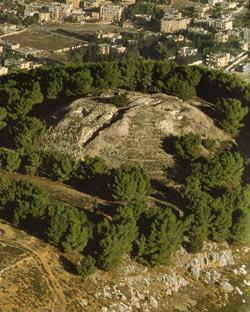Of all the spoils that come from success in war, perhaps the least appreciated is the ability to write the history. To the victor goes the narrative. When the narrative is not straightforward history but is bound to politico-religious ideology and integral to nation building, the stakes are even higher. I was reminded of this while reading an explosive article in Spiegel on ancient Samaritan and Jewish history.
In Israel’s Other Temple: Research Reveals Ancient Struggle Over Holy Land Supremacy, we learn that the Samaritans and Jews have a common and competitive history. The Samaritans at one time were the dominant Israelite tribe with a spectacular temple that was the political and religious center of the region. Jerusalem at the time was sparsely populated and a relatively inconsequential sideshow.
Geography being a form of destiny, the Samaritans had the misfortune of being in the north where they bore the harsh brunt of Assyrian invasions. Samaria was devastated and many of its people fled 30 miles south to Jerusalem, which grew in size and importance. Leaders in Jerusalem sensed and seized opportunity, finishing the job started by the Assyrians: they destroyed Samaria and the original temple.

Mount Gerizim -- Site of Samaritan/Israelite Temple
They were not able, however, to destroy all the books and several older (i.e., Samaritan) versions of the Torah survived. These older versions tell a quite different story from the newer and revised versions written by the victors from Jerusalem:
[W]hich Torah is the original? Until recently, the generally accepted school of thought was as follows: In the fourth century BC, the Samaritans split off as a radical sect. In the Bible, they appear as outsiders and idol worshipers; they are evil. The parable of the “good Samaritan” (Luke 10:25-37) offers a rather atypical portrayal of a member of this sect.
The historian Titus Flavius Josephus, himself a Jew, mentions that the apostates erected a shrine “in all haste” in the year 330 BC, as a rather dilettantish attempt to emulate the Temple in Jerusalem.
Increasingly, though, it looks as though the Bible has handed down a distorted picture of history. Papyrus scrolls recovered from Qumran on the Dead Sea, as well as a fragment of the Bible that recently surfaced on the market for antiquities, necessitate a “complete reassessment,” says Professor Stefan Schorch.
At first — so much is clear — the Samaritans had the upper hand. Indeed, compared with Jerusalem, [the Samaritan temple on] Mount Gerizim enjoyed significantly older rights: In the great tale of the history of the chosen people, the mountain plays a key role.
Abraham, the progenitor of the Israelites — who, according to legend, roamed through the Orient as a shepherd around 1500 BC — stopped there because God had appeared to him in a wondrous vision. Later, Jacob the patriarch traveled there to build the original shrine.
In the fifth book of Moses, the mountain summit finally earns a prominent place in biblical history: After the flight from Egypt, the Israelites wandered through the Sinai desert for 40 years. At last, they reached the Jordan River from the east. Their old and weary leader gazed across the river to the promised land, where “milk and honey flow.”
Shortly before his death, Moses issued an important command: The people must first travel to Mount Gerizim. He said that six tribes should climb it and proclaim blessings, while the other six tribes should proclaim curses from the top of nearby Mount Ebal. It was a kind of ritual taking possession of the promised land.
Finally, the prophet tells the Israelites to build a shrine “made of stones” on Mount Gerizim and coat it with “plaster.” Indeed, he said, this is “the place that the Lord has chosen.”
That, in any case, is what stands in the oldest Bible texts. They are brittle papyrus scrolls that were made over 2,000 years ago in Qumran, and have only recently been examined by experts.
In the Hebrew Bible, which Jerusalem’s priests probably spent a good deal of time revising [after subjugating the Samaritans and destroying the Gerizim temple], everything suddenly sounds quite different. There is no longer any mention of a “chosen place.”
The word “Gerizim” has also been removed from the crucial passage. Instead, the text states that the Yahweh altar was erected on “Ebal.” “By naming the mountain of the curses,” says Schorch, “they wanted to cast the entire tale in a negative light, and deprive Gerizim of its biblical legitimacy.”
[Torah scholar] Stefan Schorch dates the intervention to around 150 BC. The researcher stops short of calling it fraud, though, preferring to label it an “adaptation of the Bible to their own religious view.”
There is obviously a great deal at stake here, and I expect that the scholars and archaeologists working on these issues will be attacked from all directions. Their work will obviously upset both Jews and Christians.
As the scholarly investigation continues and attacks are made, I think it important keep cui bono in mind at all times. Who is doing the attacking and what benefit do they derive from what may be the newer, revised, and mythical story?

